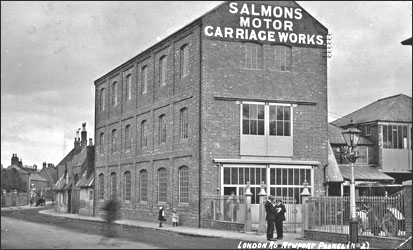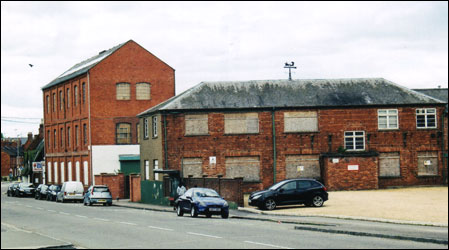![]()
The contents on this page remain on our website for informational purposes only.
Content on this page will not be reviewed or updated.
 |
|
 |
|
|
||||
|
Salmons Motor Carriage Works
|
||||
|
||||
|
With this being the month in which we celebrate Armistice Day, perhaps now is an appropriate time to mention the little known First World War story of Salmons Motor Carriage Works, of Newport Pagnell, and 6,7,8, and 9 Upper St. Martin’s Lane, London.
Following the declaration of war many of the employees volunteered for service, but for one, a German mechanic by the name of Otto Schonebrook, he was arrested and conveyed to the compound at Newbury, Berks, as a prisoner of war, this being the first occasion that a police officer had been noticed to be armed with a rifle. At their own expense, for military use several local worthies now ordered ambulances from the firm, whose reputation was such that a feature even appeared in the Daily Telegraph. Indeed, as evidence of the importance a motor ambulance designed and supplied by Salmons, and built to the order of the London Panel Doctors Committee, headed the City of London Red Cross Detachment in the Lord Mayor’s procession through London. As the war progressed a fleet of 10 motor ambulances were built to order as a gift to Russia, but apart from the best type of ambulance on the market, incorporating the ideas of Colonel Broome Giles of Bletchley, the firm were also building a motor field kitchen, which was featured in two editions of the Daily Graphic. In a demonstration of its capability personnel aboard one example, which joined up with the transport column of the City of London Red Cross, in front of the Guildhall, London, cooked a meal for 300 people during the route march to Hyde Park, where the food was then distributed. As for other activities, Salmons were agents for King cars, but unfortunately a consignment of 12 eight cylinder models was lost with the sinking of the S.S. Inkum, by a German submarine. Later in the war, to the special order of the War Office the firm would complete four Rolls Royce cars fitted with landaulet bodies for the use of the General Staff in France. These were equipped with folding tables and other accessories, to enable British officers directing operations on the Western Front to transact map work etc. while on the move, and one had already been used by General Sir Douglas Haig, the Commander in Chief. With no private work now being undertaken the firm had a War Office contract to turn out ten 3 ton lorries a week for as long as the war lasted, as well as eight ambulances a week, and in addition they were entrusted by the British War Department to build the bodies for 75 motor cars for use by the Headquarters Staff of the Russian Army, for despatch to Petrograd. Incredibly, the firm was also making toys from the left over scraps of wood, with girls, due to the shortage of manpower, being employed for this work. |
||||
|
|
||||
|
|
||||


